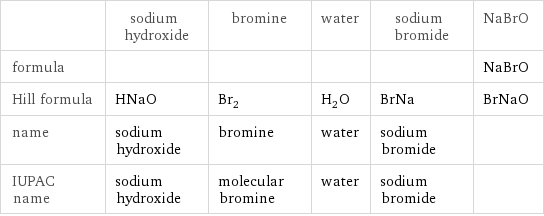Input interpretation

sodium hydroxide + bromine ⟶ water + sodium bromide + NaBrO
Balanced equation

Balance the chemical equation algebraically: + ⟶ + + NaBrO Add stoichiometric coefficients, c_i, to the reactants and products: c_1 + c_2 ⟶ c_3 + c_4 + c_5 NaBrO Set the number of atoms in the reactants equal to the number of atoms in the products for H, Na, O and Br: H: | c_1 = 2 c_3 Na: | c_1 = c_4 + c_5 O: | c_1 = c_3 + c_5 Br: | 2 c_2 = c_4 + c_5 Since the coefficients are relative quantities and underdetermined, choose a coefficient to set arbitrarily. To keep the coefficients small, the arbitrary value is ordinarily one. For instance, set c_2 = 1 and solve the system of equations for the remaining coefficients: c_1 = 2 c_2 = 1 c_3 = 1 c_4 = 1 c_5 = 1 Substitute the coefficients into the chemical reaction to obtain the balanced equation: Answer: | | 2 + ⟶ + + NaBrO
Structures

+ ⟶ + + NaBrO
Names

sodium hydroxide + bromine ⟶ water + sodium bromide + NaBrO
Chemical names and formulas

| sodium hydroxide | bromine | water | sodium bromide | NaBrO formula | | | | | NaBrO Hill formula | HNaO | Br_2 | H_2O | BrNa | BrNaO name | sodium hydroxide | bromine | water | sodium bromide | IUPAC name | sodium hydroxide | molecular bromine | water | sodium bromide |
Substance properties

| sodium hydroxide | bromine | water | sodium bromide | NaBrO molar mass | 39.997 g/mol | 159.81 g/mol | 18.015 g/mol | 102.89 g/mol | 118.89 g/mol phase | solid (at STP) | liquid (at STP) | liquid (at STP) | solid (at STP) | melting point | 323 °C | -7.2 °C | 0 °C | 755 °C | boiling point | 1390 °C | 58.8 °C | 99.9839 °C | 1396 °C | density | 2.13 g/cm^3 | 3.119 g/cm^3 | 1 g/cm^3 | 3.2 g/cm^3 | solubility in water | soluble | insoluble | | soluble | surface tension | 0.07435 N/m | 0.0409 N/m | 0.0728 N/m | | dynamic viscosity | 0.004 Pa s (at 350 °C) | 9.44×10^-4 Pa s (at 25 °C) | 8.9×10^-4 Pa s (at 25 °C) | | odor | | | odorless | |
Units
